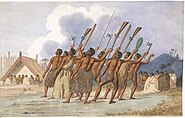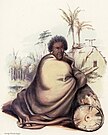Musket Wars
| The Musket Wars | |||||||
|---|---|---|---|---|---|---|---|
| |||||||
| |||||||
| Belligerents | |||||||
| Māori | |||||||
| Casualties and losses | |||||||
|
Up to 40,000 Māori 30,000 enslaved or forced to migrate 300Moriorideaths, 1700 Moriori enslaved | |||||||
TheMusket Warswere a series of as many as 3,000 battles and raids fought throughoutNew Zealand(including theChatham Islands) amongMāoribetween 1806 and 1845,[1]after Māori first obtainedmusketsand then engaged in an intertribalarms racein order to gain territory or seek revenge for past defeats.[2]The battles resulted in the deaths of between 20,000 and 40,000 people and the enslavement of tens of thousands of Māori and significantly altered therohe,or tribal territorial boundaries, before the signing of theTreaty of Waitangiin 1840.[3][4]The Musket Wars reached their peak in the 1830s,[5]with smaller conflicts between iwi continuing until the mid 1840s; some historians argue theNew Zealand Warswere (commencing with theWairau Affrayin 1843 andFlagstaff Warin 1845) a continuation of the Musket Wars.[6]The increased use of muskets in intertribal warfare led to changes in the design ofpāfortifications, which later benefited Māori when engaged in battles with colonial forces during the New Zealand Wars.[6]
NgāpuhichiefHongi Hikain 1818 used newly acquired muskets to launch devastating raids from hisNorthlandbase into theBay of Plenty,where local Māori were still relying on traditional weapons of wood and stone. In the following years he launched equally successful raids oniwiinAuckland,Thames,WaikatoandLake Rotorua,[3]taking large numbers of his enemies as slaves, who were put to work cultivating and dressingflaxto trade with Europeans for more muskets. His success prompted otheriwito procure firearms in order to mount effective methods of defence and deterrence and the spiral of violence peaked in 1832 and 1833, by which time it had spread to all parts of the country except the inland area of theNorth Islandlater known as theKing Countryand remote bays and valleys ofFiordlandin theSouth Island.In 1835, the fighting went offshore as members ofNgāti MutungaandNgāti Tamainvaded and murderedtheMorioriof Rēkohu in a genocide.
With as many as 40,000 killed over a 40-year period, the death toll of the Musket Wars was absolutely unprecedented. HistorianMichael Kingsuggested the term "holocaust" could be applied to the period;[7]another historian,Angela Ballara,has questioned the validity of the term "musket wars", suggesting the conflict was no more than a continuation of Māoritikanga(custom), but more destructive because of the widespread use of firearms.[8]The wars have been described as an example of the "fatal impact" of indigenous contact with Europeans.[8]
Origin and escalation of warfare[edit]
Māori began acquiring European muskets in the early 19th century fromSydney-based flax and timber merchants. Because they had never had projectile weapons, they initially sought guns for hunting. Their first known use in intertribal fighting was in the 1807battle of Moremonuibetween Ngāpuhi andNgāti Whātuain Northland near present-dayDargaville.Although they had some muskets, Ngāpuhi warriors struggled to load and reload them and were defeated by an enemy armed only with traditional weapons—the clubs and blades known aspatuandtaiaha.However, soon after, members of the Ngāti Korokorohapūof Ngāpuhi suffered severe losses in a raid on the Kai Tutaehapudespite outnumbering their foe ten to one, because the Kai Tutae were equipped with muskets.[7]
Under Hongi Hika's command, Ngāpuhi began amassing muskets and from about 1818 began launching effective raids onhaputhroughout the North Island against whom they had grievances. Rather than occupy territory in areas they defeated their enemy, they seizedtaonga(treasures) and slaves, whom they put to work to grow and prepare more crops—chiefly flax and potatoes—as well as pigs to trade for even more weapons. A flourishing trade in thesmoked headsof slain enemies and slaves also developed. The custom ofutu,or reciprocation, led to a growing series of reprisals as otheriwirealised the benefits of muskets for warfare, prompting an arms race among warring groups.[7]In 1821 Hongi Hika travelled to England with missionaryThomas Kendalland in Sydney on his return voyage traded the gifts which he had obtained in England for between 300 and 500 muskets, which he then used to launch even more devastating raids, with even bigger armies, againstiwifrom the Auckland region toRotorua.[7][8]
Use of the musket by Māori[edit]
The last of the non-musket wars, the 1807Battle of Hingakaka,was fought between two opposing Māori alliances near modernTe Awamutu,with an estimated 16,000 warriors involved,[9]although as late as about 1815 some conflicts were still being fought with traditional weapons. The musket slowly put an end to the traditional combat of Māori warfare using mainly hand weapons and increased the importance of coordinated group manoeuvre. One-on-one fights such asPotatau Te Wherowhero's at the battle of Okoki in 1821 became rare.
Initially, the musket was used as a shock weapon, enabling traditional and iron weapons to be used to great effect against a demoralised foe. But by the 1830s equally well-armedtauaengaged each other with varying degrees of success. Māori learnt most of their musket technology from the variousPākehā Māoriwho lived in the Bay of Islands and Hokianga area. Some of these men were skilled sailors well experienced in the use of muskets in battles at sea. Māori customised their muskets; for example, some enlarged the touch holes which, while reducing muzzle velocity, increased rate of fire.
Quality of muskets[edit]
Most muskets sold were low quality, short barrel trade muskets, made cheaply inBirminghamwith inferior steel and less precision in the action. Māori often favoured thetupara(two barrel), shotguns loaded with musket balls, as they could fire twice before reloading. In some battles, women were used to reload muskets while the men kept on fighting. Later this presented a problem for the British and colonial forces during the New Zealand Wars wheniwiwould keep women in the pā.
Māori found it very hard to obtain muskets as the missionaries refused to trade them or sell powder or shot. TheNgāpuhiput missionaries under intense pressure to repair muskets even at times threatening them with violence. Most muskets were initially obtained while in Australia. Pākehā Māori such asJacky Marmonwere instrumental in obtaining muskets from trading ships in return for flax, timber and smoked heads.
Conflicts and consequences[edit]
The violence brought devastation for many tribes, with some wiped out as the vanquished were killed or enslaved, and tribal boundaries were completely redrawn as large swathes of territory were conquered and evacuated. Those changes greatly complicated later dealings with European settlers wishing to gain land.
Between 1821 and 1823 Hongi Hika attacked Ngāti Pāoa in Auckland,Ngāti MaruinThames,Waikato tribes at Matakitaki, andTe ArawaatLake Rotorua,heavily defeating them all. In 1825 he gained a major military victory over Ngāti Whātua atKaiparanorth of Auckland, then pursued survivors into Waikato territory to gain revenge for Ngāpuhi's 1807 defeat. Ngāpuhi chiefsPōmareand Te Wera Hauraki also led attacks on the East Coast, and in Hawke's Bay and the Bay of Plenty. Ngāpuhi's involvement in the musket wars began to recede in the early 1830s.[3]
Waikato tribes expelledNgāti ToachiefTe RauparahafromKāwhiain 1821, defeated Ngāti Kahungunu at Napier in 1824 and invaded Taranaki in 1826, forcing a number of tribal groups to migrate south. Waikato launched another major incursion into Taranaki in 1831–32.[3]

Te Rauparaha, meanwhile, had moved first to Taranaki and then to theKāpiti coastandKapiti Island,which Ngāti Toa chiefTe Pēhi Kupecaptured from the Muaupoko people. About 1827 Te Rauparaha began leading raids into the north of the South Island; by 1830 he had expanded his territory to includeKaikōuraandAkaroaand much of the rest of the South Island.[3]
The final South Island battles took place in Southland in 1836–37 between forces ofNgāi TahuleaderTūhawaikiand those of Ngāti Tama chief Te Puoho, who had followed a route fromGolden Baydown the West Coast and across theSouthern Alps.
Chatham Islands[edit]
In 1835 Ngāti Mutunga, Ngāti Tama and Ngāti Toa warriors hijacked a ship to take them to theChatham Islandswhere they slaughtered about 10 per cent of theMoriori peopleand enslaved the survivors, before sparking war among themselves.[3]
Te Ihupuku Pā[edit]
The final conflict of the Musket Wars occurred in 1845. ANgāti Tūwharetoawar party was stopped en route to an attack on theNgā RauruTe Ihupuku Pāin South Taranaki by British and church officials. The AnglicanBishop of New Zealandand a Major managed to talk both sides out of fighting. Ngāti Tūwharetoa fired the final shots of the Musket Wars symbolically into the air before returning to Taupō.[10]
Historiography[edit]
HistorianJames Belichhas suggested "Potato Wars" as a more accurate name for these battles, due to the revolution thepotatobrought to the Māori economy.[11]Historian Angela Ballara says that new foods made some aspects of the wars different.[11]Potatoes were introduced in New Zealand in 1769[12]and they became a key staple with better food-value for weight thankūmara(sweet-potato), and easier cultivation and storage. Unlike the kūmara with their associated ritual requirements, potatoes were tillable by slaves and women and this freed up men to go to war.[3]
Belich saw this as a logistical revolution, with potatoes effectively fueling the long-rangetauathat made the musket wars different from any fighting that had come before. Slaves captured in the raids were put to work tending potato patches, freeing up labour to create even largertaua.The duration of the raids was also longer by the 1820s; it became common for warriors to be away for up to a year because it was easier to grow a series of potato crops.
In popular culture[edit]
The music video of "Kai Tangata" from New Zealand thrash metal bandAlien Weaponrydramatically portrays part of the conflict that ensued with introduction of the muskets.[13]
The Convertis a film set amid the conflict.[14]
References[edit]
Citations[edit]
- ^Crosby 1999,p. 1.
- ^Bohan, Edmund (2005).Climates of War: New Zealand Conflict 1859–69.Christchurch: Hazard Press. p. 32.ISBN9781877270963.
- ^abcdefgKeane, Basil (2012)."Musket wars".Te Ara, the Encyclopedia of New Zealand.Ministry for Culture and Heritage.Retrieved4 November2015.
- ^Sinclair, Keith (2000).A History of New Zealand(2000 ed.). Auckland: Penguin. pp. 41–42.ISBN978-0-14-029875-8.
- ^Crosby 1999,p. 23.
- ^abO'Malley 2019,p. 19.
- ^abcdMichael King (2003).The Penguin History of New Zealand.Penguin Books. pp. 131–139.ISBN978-0-14-301867-4.
- ^abcWatters, Steve (2015)."Musket wars".New Zealand History.Ministry for Culture and Heritage.Retrieved5 November2015.
- ^Tainui. Leslie G. Kelly. pp. 287–296. Cadsonbury. 2002.
- ^"Season 2 Ep 8: The Musket Wars".Radio New Zealand.17 August 2022.
- ^abOverview – Musket Wars,New Zealand Ministry for Culture and Heritage. Updated 15 October 2009. Retrieved 23 September 2010.
- ^Potato history, Spread of the potatoArchived11 December 2008 at theWayback Machine,Eu-Sol, (European Commission) Updated 15 September. Retrieved 15 September 2011.
- ^"ALIEN WEAPONRY – Kai Tangata (Official Video)".Napalm Records. 12 May 2018.Retrieved17 July2020– via YouTube.
- ^Frater, Patrick; Yossman, K.J. (6 May 2022)."New Zealand Epic 'The Convert' to Star Guy Pearce, Te Kohe Tuhaka, Launch at Cannes Market".Variety.Retrieved22 March2023.
Bibliography[edit]
- "The Musket Wars".New Zealand History – Ministry for Culture and Heritage. 11 September 2015.Retrieved4 February2024.
- Crosby, Ron (1999).The Musket Wars – A History of Inter-Iwi Conflict 1806–45.Auckland:A.H. Reed.ISBN0790006774.
- Ballara, Angela(2003).Taua: Musket Wars, Land Wars or tikanga? Warfare in Maori society in the early nineteenth century.Auckland: Penguin.ISBN9780143018896.
- McKinnon, Malcolm (1997).Bateman New Zealand historical atlas: Ko papatuanuku e takoto nei.David Bateman in association with Historical Branch,Department of Internal Affairs (New Zealand).ISBN1869533356.
- Belich, James,The New Zealand Wars and the Victorian Interpretation of Racial Conflict.Auckland, N.Z., Penguin, 1986
- Bentley, Trevor,Cannibal Jack,Penguin, Auckland, 2010
- Best, Elsdon,Te Pa Maori,Government Printer, Wellington, 1975 (reprint)
- Carleton, Hugh,The Life of Henry Williams, Archdeacon of Waimate(1874), Auckland NZ.Online availablefromEarly New Zealand Books(ENZB).
- Fitzgerald, Caroline,Te Wiremu – Henry Williams: Early Years in the North,Huia Publishers, New Zealand, 2011ISBN978-1-86969-439-5
- Moon, Paul,This Horrid Practice, The Myth and Reality of Traditional Maori Cannibalism.Penguin, Auckland, 2008ISBN978-0-14-300671-8
- Moon, Paul,A Savage Country. The untold story of New Zealand in the 1820sPenguin, 2012ISBN978-0-14356-738-7
- Rogers, Lawrence M. (editor)(1961) –The Early Journals of Henry Williams 1826 to 1840.Christchurch: Pegasus Press.online availableatNew Zealand Electronic Text Centre(NZETC) (2011-06-27)
- O'Malley, Vincent(2019).The New Zealand Wars Ngā Pakanga O Aotearoa.Bridget Williams Books.ISBN9781988587011.
- Ryan T and Parham B,The colonial NZ Wars ",Grantham House, 2002
- Waitangi Tribunal,Te Raupatu o Tauranga Moana – Report on Tauranga Confiscation Claims,Waitangi Tribunal Website, 2004
- Wright, Matthew,Guns & Utu: A short history of the Musket Wars(2012), Penguin,ISBN9780143565659
External links[edit]
- "TAURANGA MAORI AND THE CROWN, 1840–64",from www.waitangi-tribunal.govt.nz
- Musket Wars discussion essay,forNCEAlevel 3
- Map of iwi movements in the 1820s
- Maori Wars of the Nineteenth Centuryby S Percy Smith (1910, revised edition)






